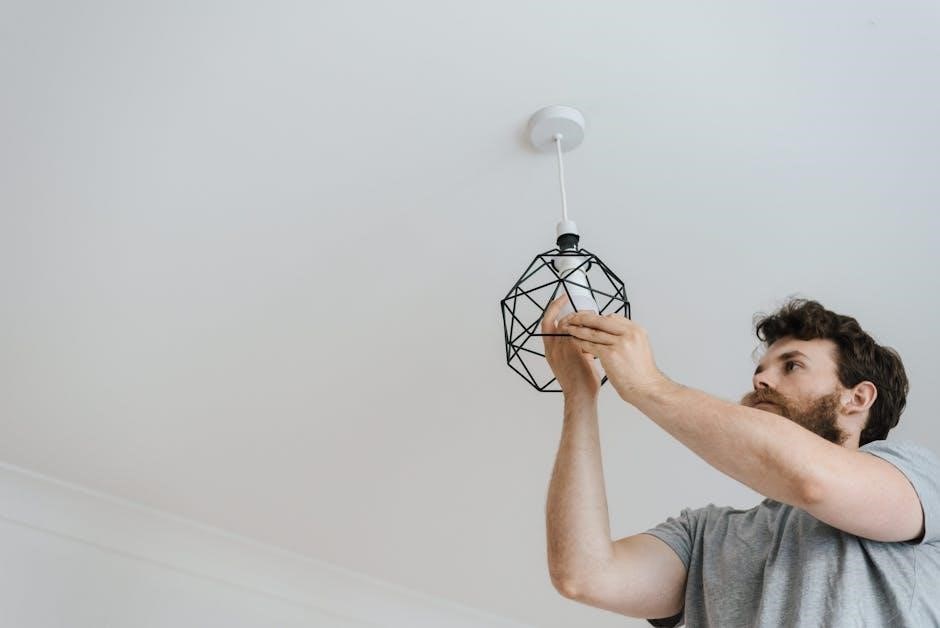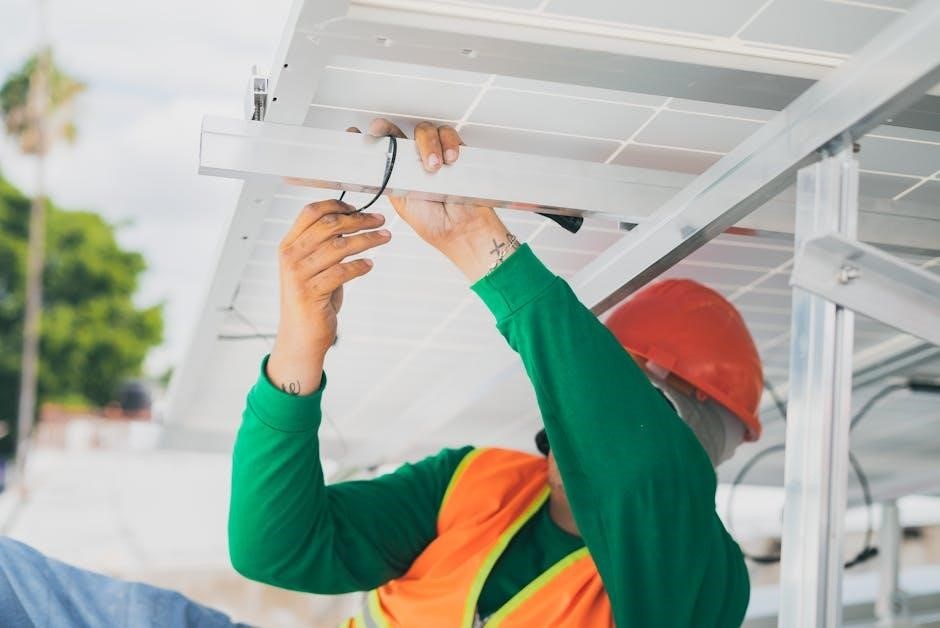Overview of the Rolls MX401 Mixer
The Rolls MX401 is a versatile, compact mixer designed for mixing up to four microphones or line-level XLR inputs into two balanced stereo outputs.
The Rolls MX401 is a compact, four-channel stereo mixer designed to combine microphones or line-level XLR inputs into balanced stereo outputs. It features individually switchable phantom power, level controls, and pan adjustments, making it ideal for sound reinforcement, field recording, and video production. Its rugged design and flexible operation suit both mobile and fixed installations;
1.2 Key Features and Applications

The Rolls MX401 offers four XLR inputs with individual phantom power, level controls, and pan adjustments. Its balanced stereo outputs ensure high-quality audio distribution. Ideal for live sound, video production, and field recording, this mixer is compact and durable, making it perfect for mobile setups and professional installations where versatility and reliability are essential.

Key Features of the Rolls MX401
The Rolls MX401 features four-channel XLR inputs with individual phantom power and level controls, along with balanced stereo XLR outputs for professional-grade audio mixing.
2.1 Four-Channel XLR Inputs
The Rolls MX401 features four XLR inputs, each with individual phantom power, MIC/LINE level selection, and level control. These inputs accommodate microphones or line-level signals, offering flexibility for various audio sources. The pan control allows precise stereo imaging, while the rugged design ensures reliable performance in both live and studio environments.
2.2 Balanced Stereo XLR Outputs
The Rolls MX401 offers two balanced stereo XLR outputs, providing clean and stable audio signals. These outputs are ideal for connecting to mixers, recorders, or sound systems, ensuring high-quality audio distribution. The balanced design minimizes noise and interference, making them suitable for professional applications in live sound, studio recording, and field production environments.
2.3 Phantom Power and Level Controls
The Rolls MX401 features individually switchable phantom power for each channel, accommodating condenser microphones. Each input includes a MIC/LINE level selector and an independent level control, allowing precise adjustment of signal levels. This ensures optimal audio quality and flexibility for various applications, from live sound to studio recordings.
Specifications of the Rolls MX401
The MX401 features 600 Ohms input impedance for MIC and 10k Ohms for LINE, with THD + Noise of 0.02% and a 96 dB S/N ratio.
3.1 Input and Output Impedance
The Rolls MX401 features an input impedance of 600 Ohms for MIC and 10k Ohms for LINE, ensuring compatibility with a wide range of audio sources. Similarly, the output impedance is also 600 Ohms for MIC and 10k Ohms for LINE, providing a stable and balanced signal transmission to connected devices.
3.2 THD + Noise and S/N Ratio
The Rolls MX401 boasts a low Total Harmonic Distortion (THD) + Noise level of 0.02%, ensuring clean and accurate audio reproduction. With a Signal-to-Noise (S/N) Ratio of 96 dB, the mixer delivers exceptional clarity and minimal background noise, making it ideal for professional audio applications where high fidelity is essential.
3.4 Phantom Power and Gain Range
The Rolls MX401 features individually switchable phantom power for each channel, accommodating condenser microphones. The mixer offers a wide gain range, allowing precise level adjustment for both microphone and line-level inputs. This flexibility ensures optimal signal quality and versatility for various audio sources in professional and creative applications.

Installation and Setup Guide
Unpack and inspect the MX401 for damage. Connect inputs and outputs, then plug in the power supply. Follow the manual for initial setup and configuration.
4.1 Unpacking and Inspection
Carefully unpack the MX401 mixer and inspect for any visible damage. Check the box contents, including the mixer, power supply, and manual. Ensure all components are included and undamaged. If damage is found, contact the carrier immediately to file a claim. This step ensures your mixer is in perfect condition before setup.
4.2 Connecting Inputs and Outputs
Connect microphones or line-level devices to the four XLR inputs, ensuring each is set to the correct MIC/LINE level. Use the corresponding switches to enable phantom power if required. Route signals using the pan controls for proper stereo imaging. Finally, connect the balanced stereo XLR outputs to your desired equipment, such as amplifiers or recording devices, using high-quality XLR cables.
4.3 Power Supply and Initial Setup
Connect the provided 15V power supply (PN PS27s) to the MX401. Ensure the mixer is unpacked and inspected for damage. Plug in the power supply, then turn on the unit. Check all controls and LEDs to confirm proper operation. Set the input levels and phantom power switches as needed for your audio sources. Proceed to configure the output settings for your specific application.
Operating the Rolls MX401
Adjust input levels using the channel controls, set pan positions for stereo imaging, and enable phantom power for condenser microphones. Monitor outputs to ensure optimal audio performance.
5.1 Adjusting Levels and Pan Controls
Adjusting the levels and pan controls on the Rolls MX401 allows precise control over each channel’s volume and stereo positioning. The level controls set the input volume, while the pan knobs position the signal in the stereo field, creating a balanced and immersive mix. This feature is essential for both live sound and studio applications.
5.2 Using the Phantom Power Switch
The Rolls MX401 features individually switchable phantom power for each channel, enabling compatibility with condenser microphones. To activate, simply flip the phantom power switch on the desired channel. This feature is essential for capturing high-quality audio from microphones that require external power, ensuring optimal performance in various recording and live sound applications.
5.3 Monitoring and Output Configuration
The Rolls MX401 provides balanced stereo XLR outputs and a front panel 1/8″ stereo output for flexible monitoring. Users can configure outputs to suit their setup, ensuring high-quality audio reproduction. The balanced XLR outputs are ideal for professional systems, while the 1/8″ output offers convenience for headphones or consumer-grade equipment, enabling seamless monitoring in both live and studio environments.
Troubleshooting Common Issues
The Rolls MX401 manual addresses common issues like no audio output, distortion, and phantom power malfunctions. It provides step-by-step solutions and tips for quick resolution.
6.1 No Audio Output
If the MX401 produces no audio, check input connections, ensure levels are adjusted, and verify phantom power is enabled if using condenser mics. Confirm outputs are connected correctly and volume controls are not muted. Power supply issues or faulty cables may also cause silence. Refer to the manual for detailed troubleshooting steps.
6.2 Distortion or Noise in the Signal
Distortion or noise in the MX401’s signal can result from improper gain staging or high input levels. Check connections for loose cables and ensure balanced XLR outputs are used. Verify phantom power is enabled only for condenser mics. Adjust levels to avoid clipping, and confirm all inputs are properly matched. Clean power supply and correct cable shielding are essential.
6.3 Phantom Power Malfunction
If phantom power fails, check the 48V switch on the affected channel. Verify the power supply is functioning and properly connected. Ensure the phantom power switch is fully engaged. Test with a known working condenser microphone. If issues persist, contact Rolls support or refer to the manual for further troubleshooting steps;

Accessories and Additional Equipment
The MX401 includes a 15V power supply and an owner’s manual. Additional equipment like XLR cables and a carrying case can enhance its portability and functionality.
7.1 Included in the Box
The Rolls MX401 package includes the mixer unit, a 15V power supply (PN PS27s), and a comprehensive owner’s manual. Additional accessories like XLR cables or a carrying case may be purchased separately for enhanced functionality and portability.
7.2 Recommended Additional Gear
To enhance the functionality of the Rolls MX401, consider adding high-quality XLR cables, a durable carrying case, and a power conditioner for stable operation. Additionally, a rack mount kit can be useful for installation setups, while studio-grade headphones and a reliable audio interface can complement the mixer for professional recording and monitoring.
Understanding the Rolls MX401 Manual
The Rolls MX401 manual provides comprehensive guidance on operating the mixer, including setup, troubleshooting, and maximizing its features for optimal performance in various audio applications.
8.1 Navigating the Manual
The Rolls MX401 manual is structured to guide users through setup, operation, and troubleshooting. It includes sections like introduction, specifications, and safety precautions, ensuring easy access to critical information. The manual’s clear layout and detailed explanations help users navigate efficiently, making it a valuable resource for optimizing mixer performance and addressing common issues.
8.2 Important Safety Precautions
The Rolls MX401 manual emphasizes proper handling to ensure safe operation. Users should avoid exposing the mixer to moisture, extreme temperatures, or physical stress. It advises unpacking and inspecting for damage, using the provided power supply, and storing the unit correctly to prevent malfunction. Adhering to these guidelines ensures optimal performance and longevity of the mixer.

Applications for the Rolls MX401
The Rolls MX401 is ideal for live sound reinforcement, field recording, and studio use. It excels in video production, sound reinforcement, and installation setups, offering versatility for professional audio needs.
9.1 Live Sound Reinforcement
The Rolls MX401 excels in live sound reinforcement, offering a portable, rugged design perfect for on-the-go setups. Its four-channel XLR inputs with switchable phantom power support condenser microphones, while balanced stereo outputs ensure high-quality audio. The mixer’s compact size and ease of use make it ideal for live performances and mobile sound applications.
9.2 Field Recording and Video Production
The Rolls MX401 is ideal for field recording and video production, offering portability and high-quality audio mixing. Its compact design fits easily into tight spaces, while switchable phantom power supports condenser microphones. Balanced XLR outputs ensure reliable audio capture, making it a reliable choice for professional field and video applications.
9.3 Studio and Installation Use
The Rolls MX401 excels in studio and installation environments, providing reliable audio mixing with its robust design. Its balanced XLR outputs and switchable phantom power make it ideal for permanent setups or professional studios. The compact size and durable construction ensure long-term performance, making it a versatile tool for installations and studio applications.

Comparisons with Similar Mixers
The Rolls MX401 stands out among four-channel mixers for its compact design, flexible phantom power, and balanced XLR outputs, making it a reliable choice for various applications.
10.1 vs. Other Four-Channel Mixers
The Rolls MX401 distinguishes itself with its robust build, intuitive interface, and versatile features. Unlike many four-channel mixers, it offers individually switchable phantom power, precise level controls, and a built-in 1/8″ stereo output for monitoring. Its compact design and competitive pricing make it a standout choice for professionals seeking reliability and flexibility in various audio applications.
10.2 Unique Selling Points of the MX401
The MX401 stands out with its individually switchable phantom power on each XLR input, ensuring flexibility for microphones. Its balanced stereo XLR outputs provide high-quality audio. The mixer’s compact, rugged design makes it ideal for mobile setups, and its efficient, reliable performance is backed by a 15V power supply. Made in the USA, it comes with a comprehensive manual for ease of use.
Maintenance and Longevity Tips
Regularly clean the mixer to prevent dust buildup and ensure optimal performance. Store it in a dry, cool place to avoid moisture damage. Perform routine checks on all XLR inputs and outputs to maintain signal integrity. Use a high-quality power supply to preserve longevity and reliability.
11.1 Cleaning and Storage
Use a soft, dry cloth to wipe the mixer and controls, avoiding harsh chemicals. Store the MX401 in a protective case or bag to prevent scratches. Keep it in a cool, dry environment, away from direct sunlight and moisture. Ensure all cables are securely stored to prevent damage during transport. Avoid extreme temperatures or humidity to maintain optimal performance and longevity.
11.2 Regular Checks and Upkeep
Regularly inspect all cables and connections for damage or wear. Check the mixer for physical damage and ensure all controls function properly. Test inputs and outputs to confirm signal flow. Verify the power supply is stable and free from noise; Clean the unit with a soft cloth to remove dust and dirt. Ensure firmware is updated if applicable.
The Rolls MX401 mixer is a versatile and reliable tool for audio professionals and enthusiasts alike. Its compact design, robust features, and ease of use make it ideal for various applications, from live sound to field recording. With proper care, it offers long-term durability and exceptional performance, delivering great value for its price.
12.1 Summary of the MX401’s Value
The Rolls MX401 offers exceptional value as a compact, four-channel mixer with versatile features like phantom power and balanced outputs. Its rugged design and efficiency make it ideal for mobile and field applications. With high-quality performance and durability, it provides excellent return on investment for professionals and enthusiasts seeking reliable audio mixing solutions.
12.2 Final Recommendations
The Rolls MX401 is highly recommended for professionals and enthusiasts seeking a reliable, versatile mixer for live sound, field recording, or studio use. Its ease of use, robust build, and excellent audio quality make it an outstanding choice for various applications. For those needing a compact, high-performance mixer, the MX401 delivers exceptional value and reliability.

























































